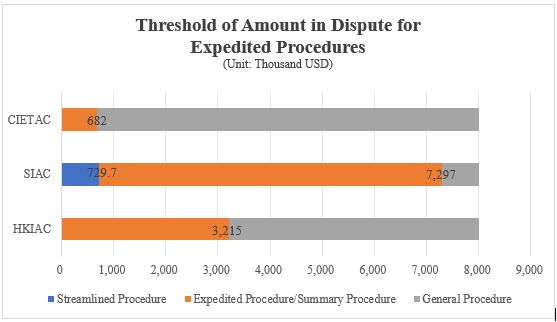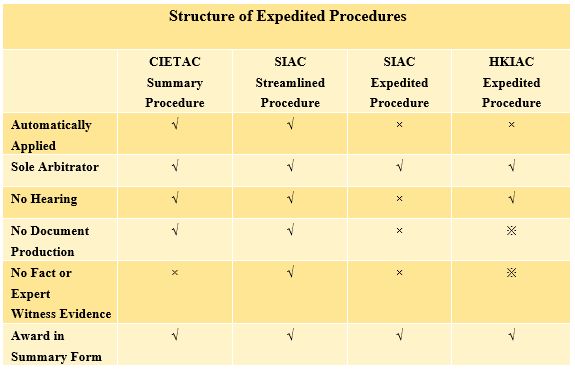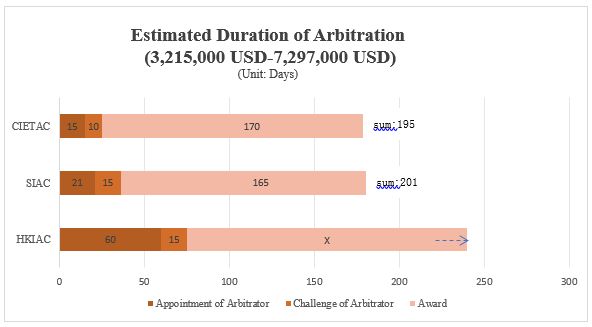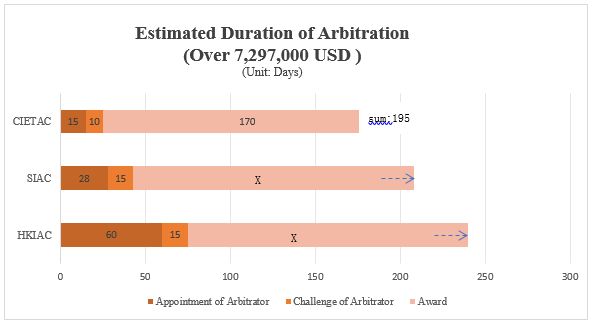Asia’s most popular arbitration institutions, CIETAC, SIAC, and HKIAC, have all revised their arbitration rules in the last 2 years. These revisions have sought to introduce new measures enhancing the efficiency of arbitration. As a quick path to an efficient arbitration, the expedited arbitration procedures may be of particular interest to commercial parties. Focusing on the expedited arbitration procedures in the CIETAC, SIAC, and HKIAC arbitration rules, this analysis provides an overview of the threshold amounts for expedited procedures, the structural features of each procedure and potential risks in the adoption of such procedures – notably with imperfect estimations of the arbitration duration.
In the 2021 International Arbitration Survey conducted by Queen Mary University of London and White & Case LLP, three of the five most preferred arbitral institutions globally are based in Asia. These are the SIAC, HKIAC, and CIETAC. Notably, all three of these institutions have revised their arbitration rules in the past two years to incorporate innovative measures to improve the efficiency of arbitration procedure. CIETAC’s revised arbitration rules took effect from January 1, 2024; HKIAC’s 2024 Administered Arbitration rules, came into effect on June 1, 2024; and the SIAC has recently unveiled its 2025 rules, which took effect from January 1, 2025. These updates now provided diversified choices of expedited procedures to allow arbitration users to resolve their disputes in a pre-established legal framework faster than ever, whether by prior agreement incorporated in the arbitration clause, or after the commencement of arbitral proceedings.
By providing a comprehensive overview of the expedited procedures in the CIETAC, HKIAC, and SIAC arbitration rules, this analysis aims to help practitioners and arbitration users make informed decisions about the most suitable arbitration institutions, depending on the possible amounts in dispute.
I. Overview
The general provisions of the three institutional arbitration rules under consideration are designed for international cases with a large amount in dispute, complicated factual context, and parties from different jurisdictions, where diversified tools are offered for the parties and tribunals to tackle the case. The expedited procedure, by contrast, is conducted in a streamlined manner with shorter time limits and fewer options for time-consuming proceedings such as document production and witness evidence. By contrast, expedited procedures tend to be incorporated in the relevant arbitration rules as an independent chapter or in the schedules with a few changes to the general provisions. Further, the expedited procedures are normally applicable when the amount in dispute does not exceed a specific amount or when the parties have all agreed to apply the expedited procedure.
The following chart demonstrates the threshold of each expedited procedure, namely the CIETAC Summary Procedure, SIAC Streamlined Procedure, SIAC Expedited Procedure, and HKIAC Expedited Procedure.

With the amount in dispute denominated in the same currency, comparisons are easier to draw. The CIETAC Summary Procedure and SIAC Streamlined Procedure aim to resolve similar scale disputes, with amounts in dispute not exceeding 682,000 USD or 729,700 USD, in the fastest manner. Together with the SIAC Streamlined Procedure, the SIAC Expedited Procedure covered the widest range of amounts in dispute, with amounts in dispute not exceeding 7,297,000 USD all falling within the scope of SIAC fast-track procedures.
Before diving into the detailed features of each expedited procedure, it is helpful to consider the key points that constitute the basic structure of an expedited procedure. In this regard, one preliminary point is the role of interlocutory proceedings. It is well known that interlocutory proceedings are very flexible depending on the parties’ views and the all the circumstances of the case. Therefore, it is not always easy to draw solid conclusions as to whether certain interlocutory proceedings are included in expedited procedures. As for the key procedural phases in proceedings, the following chart seeks to provide some indication of the extent to which they are covered in the expedited procedural rules under consideration. In the chart, “√” is used when that step is recommended in the corresponding procedure rule, “×” is used when that step is not recommended in the corresponding procedure rule, and “※” is used when that step is not mentioned in the corresponding procedure rule and the Tribunal has the power to decide on this matter after consulting with the parties.

II. The Features of Summary Procedure in CIETAC Arbitration Rules
According to the CIETAC 2024 Arbitration Rules (“CIETAC Rules”), there are four types of whole-process procedures applicable for different cases, where Emergency Arbitrator, Preliminary Determination, or similar proceedings do not fall within the scope of this discussion. The Summary Procedure (Chapter IV) is usually applicable for both foreign-related and domestic cases with amount in dispute not exceeding RMB 5,000,000, and is also applicable if the parties agree to apply the Summary Procedure regardless of the amount in dispute. For domestic cases with amounts in dispute exceeding RMB 5,000,000, the Special Provisions for Domestic Arbitration (Chapter V) are applicable. Conversely, for foreign cases with amounts in dispute exceeding RMB 5,000,000, the general provisions are applicable. Additionally, for arbitration cases accepted and administered by the CIETAC Hong Kong Arbitration Center, Special Provisions for Hong Kong Arbitration (Chapter VI) apply. This chapter is mainly designed to adapt to arbitration cases seated in Hong Kong in accordance with the Hong Kong Arbitration Ordinance (Cap. 609). As for the application of expedited arbitration procedure, Chapter IV of Summary Procedure becomes applicable.
In the CIETAC Summary Procedure:
1. The CIETAC Summary Procedure applies three measures to speed up the arbitration proceedings. These apply regardless of the parties’ views:
(1) A sole arbitrator shall be nominated (Article 61).
(2) The time limits for submission of statements of defense and counterclaim will be shortened to 20 days of the respondent’s receipt of the Notice of Arbitration (Article 62).
(3) The final award shall be made within 3 months from the date of constitution of the Tribunal, subject to any necessary extension;
2. One further measure to speed up the arbitration proceedings can be taken by the Tribunal actively after considering views of the parties:
(1) Determining the proceedings solely on the basis of the written materials and evidence submitted by the parties(Article 62).
3. Two measures to speed up the arbitration proceedings can be taken if no party requests otherwise:
(1) No document production. Document production is not included in the CIETAC Arbitration Rules. However, a similar mechanism, namely a “Request to Produce”, is included in Article 7 of the CIETAC Guidelines on Evidence, and can only be triggered by the request of either party – whether for under the expedited procedure or more generally.
(2) No submission of factual or expert witness evidence.
If the parties have prior agreement or consent after the commencement of the arbitration on any of the above aspects, the measures for expedition will not take precedence over the parties’ agreement.
III. The Features of Streamlined Procedure and Expedited Procedure in SIAC Arbitration Rules
According to SIAC 2025 Arbitration Rules (“SIAC Rules”) , there are three types of whole-process procedures. For cases with amounts in dispute not exceeding 1,000,000 SGD, the Streamlined Procedure (Schedule 2) is applicable unless the President of SIAC considers it is inappropriate (Rule 13). For both domestic and international cases with amounts in dispute exceeding 1,000,000 SGD but not exceeding 10,000,000 SGD, either party may file an application with the Registrar for the Expedited Procedure to apply (Schedule 3), and the President of the SIAC shall determine whether to grant the application (Rule 14). Cases with amounts in dispute not exceeding 1,000,000 SGD may also apply the Expedited Procedure if the President considers it appropriate (Rule 14.2). Parties can also opt in these two fast-track procedures by consent prior to the constitution of the tribunal (Rule 13.1, Rule 14.1). In the meanwhile, parties are entitled to exclude the Streamlined Procedure and Expedited Procedure by agreement in writing (Rule 14.4). For both domestic and international cases with amount in dispute exceeds 1,000,000 SGD, the general provisions of the SIAC Rules will apply if there is no application for the use of the Expedited Procedure, or any such application is not granted.
The differences between the SIAC Streamlined Procedure and Expedited Procedure are quite straightforward.
Generally, in the SIAC Streamlined Procedure, there are:
1. Five measures to speed up the arbitration proceedings, regardless of the parties’ views:
(1) A sole arbitrator shall be appointed;
(2) The time for nomination and challenge of arbitrator is abridged to 3 days;
(3) Within 5 days from the date the Tribunal is constituted, the Tribunal shall conduct a case management conference;
(4) The award shall be in summary form;
(5) The final award shall be made within 3 months from the date of constitution of the Tribunal, subject to any necessary extension;
2. Three measures to speed up the arbitration proceedings can be taken by the Tribunal after considering the views of the parties:
(1) The arbitration shall be decided on the basis of written submissions and any accompanying documentary evidence;
(2) No party shall be entitled to make requests for document production;
(3) No party shall be entitled to file any factual or expert witness evidence;
3. One measure to speed up the arbitration proceedings can be taken if no party requests otherwise:
(1) No hearing shall be conducted. If a hearing is conducted, then priority should be given to video conferencing or electronic communication;
Where the arbitration is conducted in accordance with the Streamlined Procedure, the rules and procedures set out for the Streamlined Procedure will take precedence over any inconsistent or contrary terms in the arbitration agreement, including a term providing for the appointment of a Tribunal comprising more than one arbitrator. While this rule may not be entirely reflective of party autonomy, it is reasonable to the extent that it strengths the consistency of the Streamlined Procedure.
Generally, in the SIAC Expedited Procedure, there are:
1. Three measures to speed up the arbitration proceedings, regardless of the parties’ views:
(1) A sole arbitrator shall be appointed unless the President determines otherwise;
(2) The award shall be in summary form;
(3) The final award shall be made within 6 months from the Tribunal is constituted, subject to any necessary extension;
2. Two measures to speed up the arbitration proceedings can be taken by the Tribunal after considering the parties’ views:
(1) Barring requests for document production;
(2) Limiting the length and scope of written submissions and written witness evidence;
3. Two measures to speed up the arbitration proceedings can be taken if no party requests otherwise:
(1) The arbitration shall be decided solely on the basis of written submissions and any accompanying documentary evidence;
(2) The hearing shall be conducted by video conferencing or electronic communication.
As with the Streamlined Procedure, the rules and procedures set out for the Expedited Procedure take precedence over any inconsistent terms in the arbitration agreement, including a term providing for the appointment of a Tribunal comprising more than one arbitrator.
IV. The Features of Expedited Procedure in HKIAC Arbitration Rules
Under the HKIAC 2024 Administered Arbitration Rules (“HKIAC Rules”) , there are only two types of whole-process procedures. For both domestic and international cases with amounts in dispute not exceeding HKD 25,000,000 (1at the date of January 10, 2025), either party may apply for the Expedited Procedure (Article 42) to be used. The arbitration proceedings will only be conducted in accordance with Expedited Procedure rules upon the HKIAC granting the application. Among the 184 new cases submitted to and administered by HKIAC in 2023, 15 out of 24 applications for use of the expedited procedure under the HKIAC Administered Arbitration Rules were granted 2. As is clear from the data, the Expedited Procedure is less frequently applied compared with the general procedure.
Generally, in HKIAC Expedited Procedure, there are:
Five measures to speed up the arbitration proceedings regardless of the parties’ views:
(1) A sole arbitrator shall be appointed;
(2) The award shall be in summary form,;
(3) The final award shall be made within 6 months from the date of constitution of the Tribunal, subject to any necessary extension;
(4) The arbitral tribunal shall decide the dispute on the basis of written submissions and documentary evidence, with no oral hearing.
(5) The HKIAC may abridge the time limits provided for in the Rules, as well as any other time limits that it has set.
Where the arbitration agreement provides for three arbitrators, the HKIAC shall invite the parties to agree to refer the case to a sole arbitrator. If the parties do not agree, the case shall be referred to three arbitrators (Article 42.2).
V. The Estimated Duration of Arbitration for Different Scale Cases
We now turn to an attempt at estimating the duration of a comparable case under each expedited procedure which has been assessed above. As stated before, arbitration is highly flexible with many influencing factors, including the circulation time of documents, the parties’ willingness to comply / challenge various procedural decisions, and the time taken for adjudications by the Tribunal or arbitral institution. This will necessarily render any estimate imperfect. Still, such imperfect estimations can be helpful for a user to understand the possible time which arbitral proceedings will necessitate – which in turn will have significant knock-on effects on costs.
For convenient comparison, a few assumptions are made as follows:
- The documents are presumed to be circulated by electronic communication. With the three arbitration institutions all providing online case management platforms, namely the CIETAC Online Dispute Resolution Platform, SIAC Gateway, and HKIAC Case Connect, an online service is easily accessible.
- The starting point of the duration estimation is the receipt of the notice of arbitration.
- There are no inconsistent or contrary terms in the arbitration agreement, such that the rules of expedited procedure would be fully applied.
- One month is, for ease of reference, 30 days.
- If there are challenges to the appointment of arbitrators, the arbitration proceedings are not suspended merely because of the ongoing challenges.
In accordance with the monetary threshold stipulated in the arbitration rules, cases with different amounts in dispute are categorized into four scales.

For cases with amounts in dispute not exceeding 682,000 USD, the CIETAC Summary Procedure and SIAC Streamlined Procedure will accelerate the arbitration proceedings such that an arbitral award is rendered within 3 months from the constitution of the tribunal.

For cases with amounts in dispute exceeding 729,700 USD and not exceeding 3,215,000 USD, there is no significant variation in the duration.

For cases with amounts in dispute exceeding 3,215,000 USD and not exceeding 7,297,000 USD, the duration for the tribunal to render an award is capped under the CIETAC general procedure and SIAC Expedited Procedure, subject to necessary extension. Conversely, the HKIAC general procedure focuses more on the time limits of rendering the award after the declaration of closure of proceedings, which is 3 months, subject to necessary extension.

General procedures would apply to cases with amounts in dispute exceeding 7,297,000 USD under all three arbitration rules. In this category, the arbitration duration is only capped under the CIETAC general procedure. Under the SIAC Rules and HKIAC Rules, instead of stipulating the time limits for rendering the award from the constitution of the tribunal, 3 months are given to enable the tribunal to make the final award or submit the draft award. Additionally, under the SIAC Rules, a scrutiny process occurs after the draft award is submitted, with such process to be finished as soon as practicable (Article 53.3).
VI. Conclusion
To balance the principle that parties should be permitted to fully present their cases and the principle of efficiency, different approaches have been adopted by the arbitration institutions under consideration. The CIETAC Summary Procedure is more akin to an “automatic” application, with no need for the parties to specifically file or request an application. There are clear distinctions between the SIAC Streamlined Procedure and the SIAC Expedited Procedure, making it easier for arbitration users to opt in and opt out. In terms of the HKIAC Expedited Procedure, the Tribunal and HKIAC enjoy a wider discretion in deciding how the proceedings are to be conducted. However, despite all the differences canvassed, efficiency remains of overarching importance in the context of expedited procedures. These new developments in the arbitration rules considered contribute to enhancing the efficiency of international arbitration as a dispute resolution mechanism.
Footnotes
1. Monetary Threshold for Expedited Procedure:https://www.hkiac.org/content/2024-schedule-fees
2. https://www.hkiac.org/about-us/statistics

